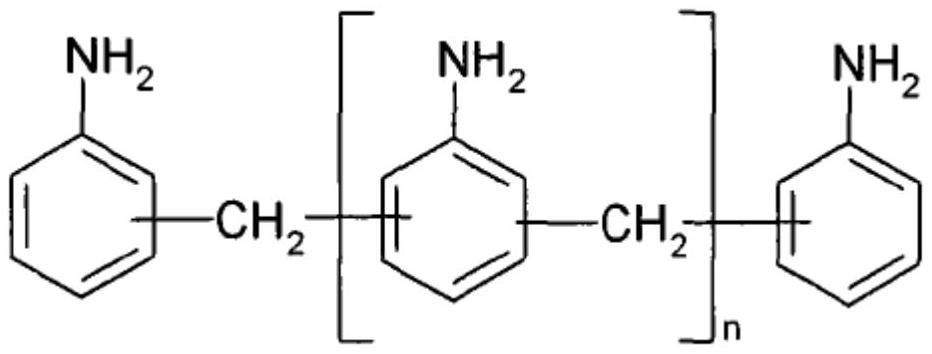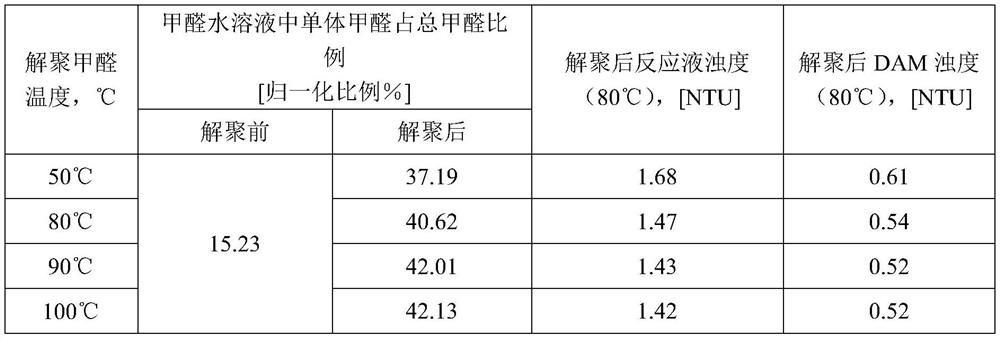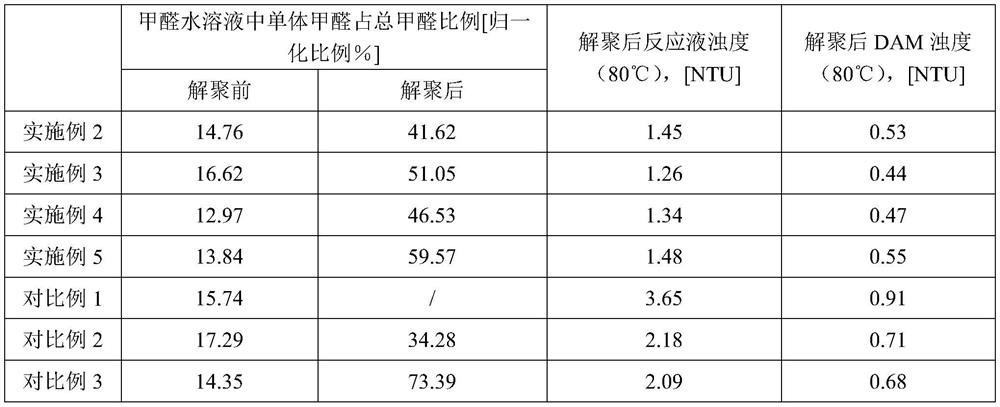A kind of preparation method of diphenylmethane series diamine and polyamine with low macromolecule impurity content
A technology of diphenylmethane and impurity content, applied in chemical instruments and methods, preparation of amino compounds, preparation of organic compounds, etc., can solve problems affecting DAM quality, continuous and smooth operation of DAM quality, equipment pipeline blockage, etc.
- Summary
- Abstract
- Description
- Claims
- Application Information
AI Technical Summary
Problems solved by technology
Method used
Image
Examples
Embodiment 1
[0033] a) Add 14.5 g of acidic formaldehyde depolymerization catalyst hydrochloric acid (mass concentration 34%) into 109.5 g of clear and transparent formaldehyde aqueous solution (store at 50°C for 72 hours, formaldehyde mass concentration is 37%, pH is 3) and stir, condense and reflux 1. In the reactor replaced by nitrogen, heat at 50° C., 80° C., 90° C., 100° C. and 300 rpm for 2.5 hours in sequence.
[0034] b) Weigh 279.0g of aniline (mass concentration ≥ 99%) and 88.6g of hydrochloric acid (mass concentration 34%), and add them to another set of reactor with stirring and condensing reflux after nitrogen replacement, at 50°C and 300rpm React for 5 minutes, then add the depolymerized formaldehyde solution in step a) for 20 minutes, the stirring speed is 300 rpm, and the reaction temperature is controlled at 60°C. After the formaldehyde solution is added for 20 minutes, raise the system temperature to 80°C and continue At 40 minutes, the clear and transparent reaction solu...
Embodiment 2
[0040] a) Add 2.9 g of acidic formaldehyde depolymerization catalyst hydrochloric acid (mass concentration 34%) into 101.3 g of clear and transparent formaldehyde aqueous solution (store at 50°C for 60 hours, formaldehyde mass concentration is 40%, pH is 3.5) and stir and condense Reflux in the reactor replaced by nitrogen, heat and reflux at 55°C and 300rpm for 1h, then add 4.2g isopropanol (mass concentration ≥ 99%) at 0.5ml / min, keep stirring and heat up to 1°C / min Heating to reflux at 85°C for 1.5h.
[0041] b) Weigh 279.0g of aniline (mass concentration ≥ 99%) and 100.2g of hydrochloric acid (mass concentration 34%), and add them to another set of reactor with stirring and condensing reflux after nitrogen replacement, at 50°C and 300rpm React at low temperature for 5 minutes, then add the depolymerized formaldehyde solution for 15 minutes, stir at 300 rpm, control the reaction temperature at 60°C, raise the system temperature to 80°C 20 minutes after the formaldehyde solu...
Embodiment 3
[0045] a) Add 17.4 g of acidic formaldehyde depolymerization catalyst sulfuric acid (mass concentration 38%) into 119.2 g of clear and transparent formaldehyde solution (store at 55°C for 52 hours, formaldehyde mass concentration is 34%, pH is 3) and stir and condense Reflux in the reactor replaced by nitrogen, heat and reflux at 50°C and 300rpm for 1h, then add 2.2g of anhydrous methanol (mass concentration ≥ 99%) at 0.5ml / min, keep stirring and heat up to 1°C / min Heating to reflux at 85°C for 1.5h.
[0046] b) Weigh 279.0g of aniline (mass concentration ≥ 99%) and 106.4g of sulfuric acid (mass concentration 38%), and add them to another set of reactor with stirring and condensing reflux after nitrogen replacement, at 50°C and 300rpm Then add the depolymerized formaldehyde solution for 20 minutes, the stirring speed is 300 rpm, and the reaction temperature is controlled at 60°C. After the formaldehyde solution is added for 20 minutes, raise the system temperature to 80°C and ...
PUM
| Property | Measurement | Unit |
|---|---|---|
| quality score | aaaaa | aaaaa |
Abstract
Description
Claims
Application Information
 Login to View More
Login to View More - R&D
- Intellectual Property
- Life Sciences
- Materials
- Tech Scout
- Unparalleled Data Quality
- Higher Quality Content
- 60% Fewer Hallucinations
Browse by: Latest US Patents, China's latest patents, Technical Efficacy Thesaurus, Application Domain, Technology Topic, Popular Technical Reports.
© 2025 PatSnap. All rights reserved.Legal|Privacy policy|Modern Slavery Act Transparency Statement|Sitemap|About US| Contact US: help@patsnap.com



